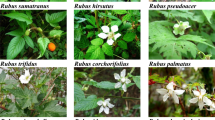Abstract
Nucleotide sequences from the internal transcribed spacer (ITS) regions of the 18S–26S nuclear ribosomal DNA have been studied from ten species ofQuercus (representing four subgenera),Castanea sativa andFagus sylvatica, as a preliminary molecular contribution to the still poorly understood systematics and evolution ofFagaceae. The resulting matrix has been used to calculate pair-wise sequence divergence indices and to construct a maximum parsimony tree forQuercus coding indels as a fifth state. Divergence is greater forQuercus vs.Fagus than forQuercus vs.Castanea. The tree for theQuercus taxa studied reveals two clearly divergent clades. In clade I the evergreen W MediterraneanQ. suber appears in a basal position as sister to more distal deciduous taxa, i.e. the E MediterraneanQ. macrolepis and the E AsiaticQ. acutissima (all formerly united as different sections under the apparently polyphyletic subg.Cerris), andQ. rubra (a representative of the N American subg.Erythrobalanus), forming a pair withQ. acutissima. In clade II the evergreen southeastern N AmericanQ. virginiana is basal and sister to the remaining three branches, i.e. a pair of evergreen Mediterranean taxa withQ. ilex andQ. coccifera (subg.Sclerophyllodrys), the deciduous but otherwise plesiomorphic SE European/SW AsiaticQ. cerris (type species of subg.Cerris), and the related but more apomorphic European pairQ. petraea andQ. robur (subg.Quercus). These results partly conflict with current taxonomic classification but are supported by some anatomical and morphological characters. They document polyphyletic lines from evergreen to deciduous taxa and suggest Tertiary transcontinental connections within the genus.
Similar content being viewed by others
References
Bachmann, K., 1992: Nuclear DNA markers in angiosperm taxonomy. — Acta Bot. Neerl.39: 369–384.
Baldwin, B. G., Sanderson, M. J., Porter, J. M., Wojciechowski, M. F., Campbell, C. S., Donoghue, M. J., 1995: The ITS region of nuclear ribosomal DNA, a valuable source of evidence on angiosperm phylogeny. — Ann. Missouri Bot. Gard.82: 247–277.
Baum, D. J., Sytsma, K. J., Hoch, P. C., 1994: A phylogenetic analysis ofEpilobium (Onagraceae) based on nuclear ribosomal DNA sequences. — Syst. Bot.19: 363–388.
Bayer, R. J., Soltis, D. E., Soltis, P. S., 1996: Phylogenetic inference inAntennaria (Asteraceae: Gnaphalieae: Cassiniinae) based on sequences from nuclear ribosomal DNA internal transcribed spacers (ITS). — Amer. J. Bot.83: 516–527.
Bellarosa, R., Delre, V., Schirone, B., Maggini, F., 1990: Ribosomal RNA genes inQuercus spp. (Fagaceae). — Pl. Syst. Evol.172: 127–139.
Camus, A., 1936–1954: Les Chênes. Monographie du genreQuercus. — Paris: Lechevalier.
Downie, S. R., Katz-Downie, D. S., 1996: A molecular phylogeny ofApiaceae subfamilyApioideae: evidence from nuclear ribosomal DNA internal transcribed spacer sequences. — Amer. J. Bot.83: 234–251.
Doyle, J. J., Doyle, J. A., 1987: A rapid DNA isolation procedure for small quantities of fresh leaf tissue. — Phytochem. Bull.19: 11–15.
Ferris, C., Oliver, R. P., Davy, A. J., Hewitt, G. M., 1993: Native oak chloroplasts reveal an ancient divide across Europe. — Molec. Ecol.2: 337–344.
Higgins, D. G., Bleasby, A. J., Fuchs, R., 1992: CLUSTAL: a new multiple sequence alignment program. — Computer Applic. Biosc.8: 189–191.
Kim, K. J., Jansen, R. K., 1994: Comparison of phylogenetic hypotheses among different data sets in dwarf dandelions (Krigia, Asteraceae): additional informations from internal transcribed spacer sequences of nuclear ribosomal DNA. — Pl. Syst. Evol.190: 157–185.
Mabberley, D. J., 1993: The plant—book. A portable dictionary of the higher plants. — Cambridge: Cambridge University Press.
Manos, P. S., 1993: Cladistic analysis of sequences from the internal transcribed spacers (ITS) of nuclear ribosomal DNA ofNothofagus. — Amer. J. Bot.80 (Suppl., abstracts): 163.
Nixon, K. C., 1993: Infrageneric classification ofQuercus (Fagaceae) and typification of sectional names. — Ann. Sci. Forest.50 (Suppl. 1): 25s-34s.
Petit, R. J., Kremer, A., Wagner, D. B., 1993a: Geographic structure of chloroplast DNA polymorphism in European oaks. — Theor. Appl. Genet.87: 122–128.
—, 1993b: Ribosomal DNA and chloroplast DNA polymorphism in a mixed stand ofQuercus robur andQ. petraea. — Ann. Sci. Forest.50 (Suppl. 1): 41s-47s.
Samuel, R., Pinsker, W., Ehrendorfer, F., 1995: Electrophoretic analysis of genetic variation within and between populations ofQuercus cerris, Q. pubescens, Q. petraea andQ. robur (Fagaceae) from Eastern Austria. — Bot. Acta108: 290–299.
Schwarz, O., 1936: Entwurf zu einem natürlichen System der Cupuliferen und der GattungQuercus L. — Notizbl. Bot. Gart. Berlin-Dahlem.13 (116): 1–22.
—, 1936–1939: Monographie der Eichen Europas, besonders des Mittelmeergebietes. — Feddes Repert., Sonderbeih.D: 1–200.
—, 1993:Quercus L. — InTutin, T. G., Heywood, V. H., Burges, N. A., Moore, D. M., Valentine, D. H., Walters, S. M., Webb, D. A., (Eds): Flora Europaea,1, 2nd edn, pp. 72–76. — Cambridge: Cambridge University Press.
Suh, Y., Thien, L. B., Reeve, H. E., Zimmer, E. A., 1993: Molecular evolution and phylogenetic implications of internal transcribed spacer sequences of ribosomal DNA inWinteraceae. — Amer. J. Bot.80: 1042–1055.
Swofford, D. L., 1993: PAUP: phylogenetic analysis using parsimony, version 3.1.1. — Champaign: Illinois Natural History Survey.
Uzunova, K., Palamarev, E., Ehrendorfer, F., 1997: Anatomical changes and evolutionary trends in the foliar epidermis of extant and fossil Euro-Mediterranean oaks (Fagaceae). — Pl. Syst. Evol.204: 141–159.
Whittemore, A. T., Schall, B. A., 1991: Interspecific gene flow in sympatric oaks. — Proc. Natl. Acad. Sci. USA88: 2540–2544.
Yuan, Y.-M., Küpfer, P., Doyle, J. J., 1996: Infrageneric phylogeny of the genusGentiana (Gentianaceae) inferred from nucleotide sequences of the internal transcribed spacers (ITS) of nuclear ribosomal DNA. — Amer. J. Bot.83: 641–652.
Zhou Zhe-Kun, Wilkinson, H., Wu Zheng-Yi, 1995: Taxonomical and evolutionary implications of the leaf anatomy and architecture ofQuercus L. subgenusQuercus from China. — Cathaya7: 1–34.
Author information
Authors and Affiliations
Rights and permissions
About this article
Cite this article
Samuel, R., Bachmair, A., Jobst, J. et al. ITS sequences from nuclear rDNA suggest unexpected phylogenetic relationships between Euro-Mediterranean, East Asiatic and North American taxa ofQuercus (Fagaceae) . Pl Syst Evol 211, 129–139 (1998). https://doi.org/10.1007/BF00984917
Received:
Revised:
Accepted:
Issue Date:
DOI: https://doi.org/10.1007/BF00984917




